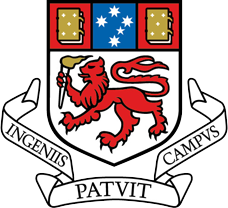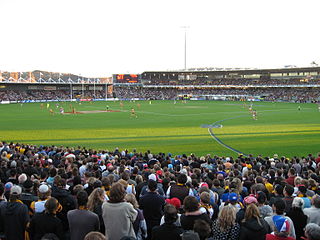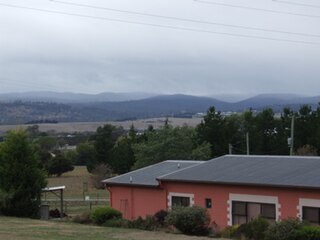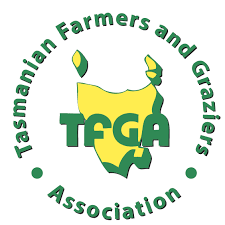
Hobart is the capital and most populous city of the island state of Tasmania, Australia. Home to almost half of all Tasmanians, it is the southernmost and least-populated Australian state capital city, and second-smallest if territories are taken into account, before Darwin, Northern Territory. Hobart is located in Tasmania's south-east on the estuary of the River Derwent, making it the most southern of Australia's capital cities. Its skyline is dominated by the 1,271-metre (4,170 ft) kunanyi/Mount Wellington, and its harbour forms the second-deepest natural port in the world, with much of the city's waterfront consisting of reclaimed land. The metropolitan area is often referred to as Greater Hobart, to differentiate it from the City of Hobart, one of the seven local government areas that cover the city. It has a mild maritime climate.

Tasmania is an island state of Australia. It is located 240 kilometres (150 miles) to the south of the Australian mainland, separated from it by the Bass Strait, with the archipelago containing the southernmost point of the country. The state encompasses the main island of Tasmania, the 26th-largest island in the world, and the surrounding 1000 islands. It is Australia's least populous state, with 569,825 residents as of December 2021. The state capital and largest city is Hobart, with around 40 percent of the population living in the Greater Hobart area. This makes it Australia's most decentralised state.

Launceston or is a city in the north of Tasmania, Australia, at the confluence of the North Esk and South Esk rivers where they become the Tamar River (kanamaluka). As of 2021, the Launceston urban area has a population of 90,953. Launceston is the second most populous city in Tasmania after the state capital, Hobart. As of 2020, Launceston is the 18th largest city in Australia. Launceston is the fifth-largest inland city and the ninth-largest non-capital city in Australia. Launceston is regarded as the most livable regional city, and was one of the most popular regional cities to move to in Australia from 2020 to 2021. Launceston was named Australian Town of the Year in 2022.

Burnie is a port city on the north-west coast of Tasmania, Australia. When founded in 1827, it was named Emu Bay, being renamed after William Burnie, a director of the Van Diemen's Land Company, in the early 1840s.

The University of Tasmania (UTAS) is a public research university, primarily located in Tasmania, Australia. Founded in 1890, it is Australia's fourth oldest university. Christ College, one of the university's residential colleges, first proposed in 1840 in Lieutenant-Governor Sir John Franklin's Legislative Council, was modelled on the Oxford and Cambridge colleges, and was founded in 1846, making it the oldest tertiary institution in the country. The university is a sandstone university, a member of the international Association of Commonwealth Universities, and the Association of Southeast Asian Institutions of Higher Learning.
Football Tasmania (FT) is the governing body for soccer in the Australian state of Tasmania. The federation oversees competitions across Tasmania, Tasmanian representative teams, and development of the sport in the state. The federation was known as the Tasmanian Soccer Association until 1996, when it was renamed to Soccer Tasmania. In line with national changes in March 2006, it became Football Federation Tasmania. In February 2019, the organisation became simply Football Tasmania.

The Royal Hobart Hospital is a public hospital in the Hobart CBD, Tasmania, Australia. The hospital also functions as a teaching hospital in co-operation with the University of Tasmania. The hospital's research facilities are known as the Royal Hobart Hospital Research Foundation. Also close to the hospital site is the Menzies Research Institute.

The Tasmanian State League (TSL), colloquially known as the Tasmanian Football League (TFL) (formerly known as the Tasmanian Australian National Football League (TANFL) and several other short-term names) is the highest ranked Australian rules football league in Tasmania, Australia.

Australian rules football in Tasmania, has been played since the late 1870s and draws the largest audience for a football code in the state.

The Tasmanian Government Railways (TGR) was the former operator of the mainline railways in Tasmania, Australia. Formed in 1872, the railway company was managed by the Government of Tasmania, and existed until absorption into the Australian National Railways Commission in 1978.
TasTAFE is a Tasmanian tertiary education body of the Australian state-based Technical and Further Education system run by the Tasmanian State Government. The main campuses are located at Hobart, Warrane, Claremont, Glenorchy, Launceston, Alanvale, Devonport and Burnie.

Metro Tasmania, commonly called Metro, a Tasmanian Government business enterprise, is the largest bus operator in the state of Tasmania, Australia, with operations in three of the four largest urban centres of Hobart, Launceston, and Burnie. Urban services in Devonport are provided by a private operator, Kinetic. Services are provided by Metro under a range of urban and non-urban contracts with the Transport Commission, a division within the Department of State Growth.

Legana is a rural and residential locality in the local government area (LGA) of West Tamar in the Launceston LGA region of Tasmania. The locality is about 32 kilometres (20 mi) south-east of the town of Beaconsfield. The 2021 census has a population of 4,769 for the state suburb of Legana. It is 12 kilometres north of Tasmania's second largest city, Launceston. It is adjacent to Riverside, Bridgenorth, Grindelwald and Rosevears.

The Tasmanian Department of Natural Resources and Environment (NRE) is the government department of the Tasmanian Government responsible for supporting primary industry development, the protection of Tasmania's natural environment, effective land and water management and the protection of Tasmania's relative disease and pest free status. NRE's responsibilities also include maintaining the security of land tenure, administration of much of the state's Crown lands and delivery of government services through Service Tasmania.
Sport in Tasmania is participation in and attendance at organised sports events in the state of Tasmania in Australia.
Statewide Australian rules football competition has been played in Tasmania, Australia under the umbrella of the Tasmanian Football League from 1986–1998, Football Tasmania from 1999–2000 until the competition was disbanded in December 2000 and AFL Tasmania from 2009 when a new ten-club competition, this time known as the Tasmanian State League, was formed.
Chudleigh is a rural locality in the local government area of Meander Valley in the Launceston region of Tasmania. The locality is about 37 kilometres (23 mi) west of the town of Westbury. The 2016 census has a population of 203 for the state suburb of Chudleigh.
The College of Health and Medicine is a college of the University of Tasmania that incorporates the School of Medicine, School of Health Sciences, Wicking Centre and Menzies Institute for Medical Research. The College incorporates medicine, pharmacy, psychology, paramedicine, nursing, laboratory medicine, allied health sciences and rural health into its curricula and research.

The Tasmanian Farmers and Graziers Association (TFGA) is the peak body for the agricultural industry in the Australian state of Tasmania. It is a member of the National Farmers Federation.













